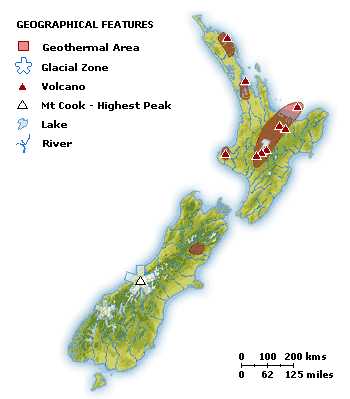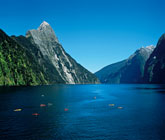New Zealand's Awesome Landscape
New Zealand’s Awesome LandscapeYou’ll find a variety of awesome landscapes in New Zealand, all within easy reach of each other. Spectacular glaciers, picturesque fiords, rugged mountains, vast plains, rolling hillsides, subtropical forest, volcanic plateau, miles of coastline with gorgeous sandy beaches — it’s all here. No wonder New Zealand is becoming so popular as a location for movies! [ more about Lord of the Rings]
What’s There?Lying in the south-west Pacific, New Zealand consists of two main islands — the North Island and the South Island. In addition, Stewart Island and many smaller islands lie offshore. The North Island has a ‘spine’ of mountain ranges running through the middle, with gentle rolling farmland on both sides. The central North Island is dominated by the Volcanic Plateau, an active volcanic and thermal area. The massive Southern Alps form the backbone of the South Island. To the east of the Southern Alps is the rolling farmland of Otago and Southland, and the vast, flat Canterbury Plains. Leaving Home - How it Began
New Zealand’s oldest rocks are over 500 million years old, and
were once part of Gondwanaland. This massive supercontinent started to
split up about 160 million years ago, and New Zealand separated from
it about 85 million years ago. |
|
|
|||||||||||
|
Earth Dramas
Being straddled over two tectonic plates and sitting on the Pacific ‘ring
of fire’ can have its disadvantages in the form of volcanoes, earthquakes
and other natural hazards. However, this subterranean activity also blesses
New Zealand with some spectacular geothermal areas and relaxing hot springs,
as well as providing electricity and heating in some areas. From Long Sandy Beaches to Wild, Rugged CoastlinesNew Zealand has over 15,000 kilometres of beautiful and varied coastline. In the Far North and on most of the East Coast of the North Island you’ll find long sandy beaches perfect for swimming, surfing and sunbathing. The North Island’s West Coast has dark sandy beaches, with sand heavy in iron. The north of the South Island has some beautiful sandy beaches, while the coastline around the rest of the South Island tends to be wilder and more rugged. Mountain Range to Fertile Farmland
About a fifth of the North Island and two-thirds of the South Island
are mountains. The existence of a ‘spine’ of mountain ranges
throughout New Zealand is also due to the movement of the earth’s
tectonic plates. Stretching from the north of the North Island to the
bottom of the South, these mountains are caused by the collision of the
Australian and Pacific Plates. |
|
|
|||||||||||
|
Glaciers of Grinding IceNew Zealand’s Southern Alps have a number of glaciers, the largest being Tasman glacier, which you can view by taking a short walk from Mount Cook village. New Zealand’s most famous glaciers are the Franz Josef and Fox on the South Island’s West Coast. Gouged out by moving ice over thousands of years, these spectacular glaciers are easily accessible to mountaineers and hikers. You can walk up to the glaciers or do a heli-hike — fly up by helicopter and walk down. Sunken Mountains
Over thousands of years, the process of subduction has seen parts of the New Zealand landscape become submerged. The Marlborough Sounds and Fiordland are examples of high mountain ranges that have ‘sunk’ into the sea, creating spectacular sounds and fiords. These areas provide some of New Zealand most picturesque scenery, with steep lush hills plunging down to the deep still bays below. Clear, deep still water surrounded by beautiful bush makes these areas ideal for boating and kayaking. |
|
|
Reviews / Comments for New Zealand's Awesome Landscape
No reviews have been written write a review now.








